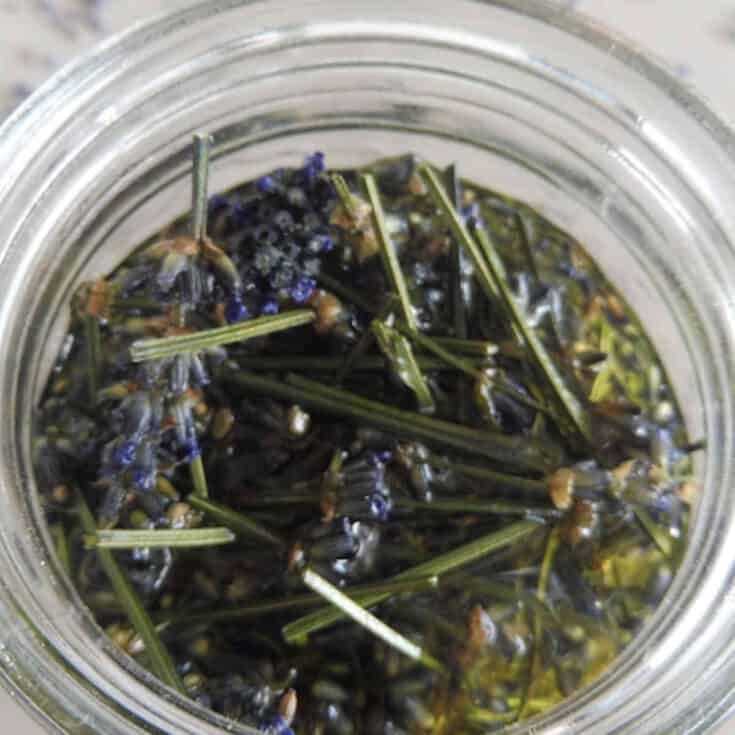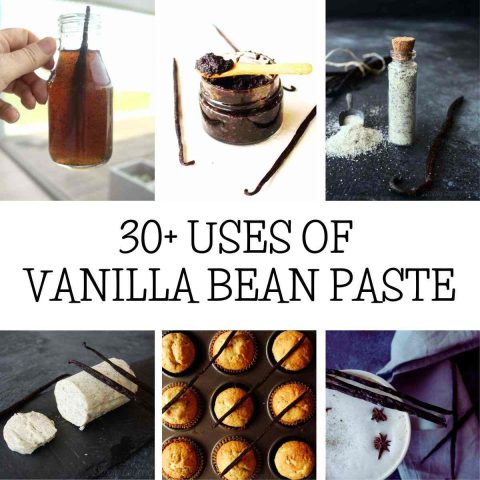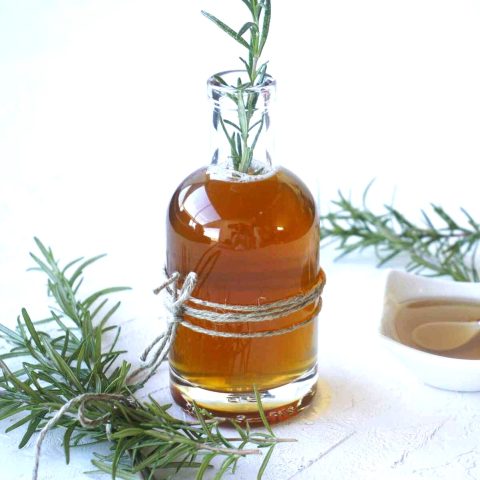This highly scented lavender-infused oil soothes minor skin irritation, mild burns, or insect bites.
Made of two ingredients this lavender infusion poses excellent calming and relaxing properties that make it perfect for soothing sore muscles or relaxing lavender bath.

I may make a commission from links in this post. That means that if you make a purchase, I will receive a small commission at no extra cost to you. See more
What is lavender infused oil
Lavender infused oil is made by the maceration of fresh or dried lavender flowers and stems in the carrier oil. Over the course of several weeks, the carrier oil extracts the soluble plant constituents, including traces of lavender essential oil. Lavender infused oil, therefore, carries the medicinal benefits of lavender as well as its scent.
How to make lavender essential oil
Lavender essential oil on the other hand is made of a distillation process that pushes steam of water through the lavender flowers. Steam with valuable oily substances is funneled into a condenser where it turns into a liquid with oil that floats on the surface where it is siphoned off. This process requires specific equipment and a huge amount of lavender flower material which makes it impossible to make at home.
Whereas a simple infusion process is easy to make with 2 handfuls of lavender and a small amount of carrier oil you can create highly scented versatile lavender infusion packed with medicinal benefits.

Ingredients
Scented Lavender
I love to use lavender in the kitchen as it gives a specific aromatic sweet fragrance to any dish. My favorite is this lavender extract that has a variety of uses and makes an excellent addition to sweet or savory dishes. This summer I experimented with lavender and made this extraordinary strawberry jam with lavender that quickly became our favorite summer jams.
However, when it comes to making lavender infusion one needs to be picky as the fragrance matters.
To make the most scented lavender infusion with a sweet aroma, English lavender (Lavandula Angustifolia) is the best choice. Dutch lavender (Lavandula intermedia) also makes scented oil however the higher content of camphor gives the lavender infusion fragrance a slightly sharper overtone.
All lavender types possess antimicrobial and anti-inflammatory properties and can be used for making potent lavender infusion, just some of their medicinal properties as well as scents might differ. Avoid lavender that grows in parks because these are treated with chemicals, use lavender from your own garden or dry in organic quality.
Fresh or dry lavender?
When it comes to oil infusion, I always suggest using dry material as the moisture from fresh flowers contributes to mold and spoilage. However, If you want to capture the lavender fragrance fresh buds are more aromatic as the fragrance fades with the drying process. Lavender, on the contrary, doesn’t have too much moisture. Wilted flowers might also be a solution. The choice is yours. So you can use Dry or fresh lavender buds, leaves, or stems. Flowers, however, have the sweetest and citrus flavor.
Carrier oil
Pay attention to the carrier oil. There are many criteria that need to be taken into account. Composition, contraindications, aroma, shelf life, price, and most importantly its benefits. Don’t forget to check its absorption rate. Depending on your desired effect you can use fast absorbing infused oils which are quickly absorbed by the skin and do not leave a greasy residue. Or carrier oils with a slow-absorbing speed which tend to leave skin with a slightly oily residue. Find detailed information about carrier oils here
Grapeseed oil
Fast absorbing grapeseed oil was my choice. Unscented, ecologic oil that is rich in antioxidants and fights with signs of aging. These are important attributes if you want to use the oil for making salves or facial creams. The grapeseed oil is also light with a nutrient-rich composition that is an ideal choice for all skin types. Other oils that you want to consider are jojoba oil, extra virgin olive oil, or rosehip seed oil
Methods of infusion
When I am not in a hurry I prefer the traditional infusion method. There are several ways you can infuse your oil. I prefer the old-school infusion where you place the mixture (lavender + carrier oil) in a warm place for 4 weeks ( heat is the main factor helping to infuse the oil but not in direct sunlight). Then filter the oil with cheesecloth to get rid of all the lavender and get only pure oil.
However, if you are in a hurry you can use the double boiler method that you can speed up the process of infusion with heat to 5 hours. Place the jar with lavender and carrier oil in a double boiler and bring it to a slow simmer. Make sure the temperature in the oil will not exceed 60 C (122 F). Thus keeping all medicinal properties.
After 5 hours remove the oil from the heat, let it cool down a bit and strain the herbal material. If you want to make the infusion even more potent you add another batch of lavender and repeat the process several times to reach the desired fragrance.
Tools
Double boiler
How to make lavender infused oil
First step
Start with lavender. Whether you decide to use dried or fresh lavender chop it into smaller pieces, cut the stems. Smaller pieces make for a better extraction.

Second step
Fill the sterilized glass jar with lavender
Third step
Pour over the grapeseed oil or other carrier oil of your choice so all herbal material is covered completely

Fourth step
Use a sterilized spoon or wooden stick to mix it thoroughly making sure that all pieces of lavender are coated and covered with the oil and all air bubbles are gone.
Fifth step
Cover the jar with a lid, you can use a piece of parchment paper to place it in between the lid and a jar.
Sixth step
Place the jar in the dark warm spot, with no direct sun to infuse for 4 weeks, shake it occasionally, add more oil if it evaporates
Seventh step
after 4 weeks strain the oil with cheesecloth, and pour into dark-colored jar.
I like to add a few drops of vitamin E that helps to slow down the oxidation process.

Lavender infused oil benefits
Known for its soothing and relaxing properties lavender infusion offers many benefits for skin and hair

Lavender oil for skin
For acne
This scented infused oil possesses antiseptic, antibacterial, and anti-inflammatory properties, It can unclog pores and help with acne and irritated skin.
Anti-aging effect
This infusion in grapeseed oil is packed with antioxidants that protects us from the free radicals responsible for wrinkles and fine lines. Similarly works this elderflower oil that I made with the same technique. It makes an excellent addition to salves or creams.
Relaxing and soothing
Well known for its calming and relaxing properties lavender soothe sore muscles and make irritated skin to relax. The scent of lavender oil provides a calming atmosphere, making you relaxed and prepared for bed.
Healing and repairing
This lavender infusion helps repair wounds and damaged skin tissues. It heals rashes, bites, burns or scars.
Lavender oil for hair
It helps promote hair growth
There are studies on mice proving that lavender oil stimulates hair growth. Moreover, their hair grew thicker and faster after the regular application. However, there are no human studies that could prove it.
May help with itchy scalp or dandruff
Its antimicrobial properties help prevent bacteria and fungi from growing thus preventing itchy scalp or infections.

Lavender infused oil uses
Masaging oil for sore muscles relief
It is great for a massage of sore and achy muscles. The best use is before you go to sleep, it makes you relax, calm and ready for a bed.
Soothing & Moisturizing
Its soothing and moisturizing properties make wonders with cracked and chapped skin. In the form of lavender salve, DIY deodorant stick, cream, or lip balm soothes your skin and keep it moisturized.
Bath oil
Add a few drops of lavender oil in a bath with a few drops of lavender or mandarin essential oil. Its moisturizing and soothing properties make your skin smooth and soft. It also works for foot massage. Add these lavender bath bombs or lavender vinegar to double the effect.
Make up remover
Use it as a makeup remover or add a few drops into your makeup remover to enjoy the antiaging and nourishing benefits of this oil.
If you follow the instructions in this post you will make highly scented lavender infusion that contains traces of lavender essential oil and smell just like lavender. The selection of scented herbal material, double infusion, and patience are the three main ingredients for success.
This lavender oil-infused in grapeseed oil is completely edible and with a specific lavender scent can enrich any sweet or savory dish.
Lavender oil

This highly scented lavender oil soothes minor skin irritation, mild burns, or insect bites.
Made of two ingredients this lavender infusion poses excellent calming and relaxing properties that make it perfect for soothing sore muscles or for a relaxing lavender bath.
Tools
- sterilised jar 500 ml
Instructions
- Start with lavender. Whether you decide to use dried or fresh lavender chop it into smaller pieces, cut the stems. Smaller pieces make for a better extraction.
- Fill the sterilized glass jar with lavender
- Pour over the grapeseed oil or other carrier oil of your choice so all herbal material is covered completely
- Use a sterilized spoon or wooden stick to mix it thoroughly making sure that all pieces of lavender are coated and covered with the oil and all air bubbles are gone.
- Cover the jar with a lid, you can use a piece of parchment paper to place it in between the lid and a jar.
- Place the jar in the dark warm spot, with no direct sun to infuse for 4 weeks, shake it occasionally, add more oil if it evaporates
- after 4 weeks strain the oil with cheesecloth, and pour into a jar of dark color.
Notes
I like to add a few drops of vitamin E that helps to slow down the oxidation process.
Recommended Products
As an Amazon Associate and member of other affiliate programs, I earn from qualifying purchases.

Collection of infusion oils you might want to try
Collection of infusion oils you might want to try
DIY rose oil for skin and hair
This highly scented and effective rose oil is a must have item in your household. Our DIY rose infused oil goes a little bit further with ultra rich grape seed oil and petals from Rose Damascena.
How to make nettle oil
This mineral-rich nettle oil is a powerful remedy with a wide spectrum of uses from easing stiff joints to scalp and hair treatment. Made of nettle leaves this effective oil might help with skin irritations or baldness.
DIY Dandelion oil to heal your cracked hands
Dandelion oil is used in salves, lotions, and lip balms to soothe dry and cracked skin. Thanks to its capability to speed up the healing process of scars and calm down skin irritations dandelion oil is also efficient in acne treatment.
Uses and benefits of Calendula oil
Calendula (Calendula Officinalis, a.k.a. “Pot Marigold”) has its well-defined place in the herbal world. It’s not only the bright color and sweet smell that distinguish this plant from the others. But mainly it’s healing power and capability to cleanse wound made it internal as well as external number one choice of herbal healer.
How to make & use red clover oil
purple blossoms of the red clover make an outstanding nourishing oil that, by increasing collagen production, improves the elasticity of your skin and reduces wrinkles. Its anti-inflammatory properties can also help with eczema or psoriasis.
Powerful Elderflower infusion oil to soften your skin
Elderflower infusion oil has a powerful soothing effect on the skin, improves skin complexion and is especially useful for older skin. However, it is also very effective in treating acne or sunburns. It's anti-inflammatory and anti-wrinkle properties made the elderflower infusion oil very popular in the cosmetic industry.
How to make Rosehip oil to heal your skin
Packed with antioxidants and fatty acids, rosehip oil is a natural versatile moisturizer that will heal your hair, nails and skin from bruises, acne and wrinkles.
How to make Violet oil and its uses
Extracted from leaves and flowers of wild violets this violet oil possesses many benefits for skin and hair and might be also able to help with insomnia or rheumatic pain.
How to make chamomile oil
This soothing chamomile oil extracted from chamomile flowers deeply nourishes and restores the skin. Its healing properties can be used in wound healing, diaper rash, or eczema.
Cucumber oil recipe for skin and hair
Deeply moisturizing and nourishing cucumber oil soothes and protects dry skin and hair adding softness and hydration.
How to make lemon balm oil + 10 ways to use it
This soothing lemon balm oil moisturizes and promotes skin healing. Lemon balm oil’s healing properties may help with cold sores.


























i really enjoy the recipes
Beautiful stuff…
Very nice..keep it up
hi! sounds like a wonderful recipe. I have som lavender that I grew and dried and would like to use it for this recipe. I am new to DIY, what does it mean to grind it with a cloth?
I appreciate your guidance.
Hi Lisa, thank you for spotting the mistake, I meant to filter the oil..
Do you use just the flowers or the flowers and leaves? I bought the grape seed oil so I am ready!!
Hi Delphine,
you can use flowers and leaves as both are medicinal and beneficial for the skin. Good luck!
This is amazing, I have been wanting to make infused oil for a while now and was unsure how to do so, I have a few questions though, first can I use Jojoba or castor oil? Will this method work with Lemon or orange rind? Can the infused oil be used in homemade soaps or bath bombs? Thanks so much for your help!
Hi Whitney, sure you can, it will have slightly different benefits for the skin though. Grapeseed oil is lighter than jojoba oil and has a great amount of vitamin E. This means it provides antioxidants for your skin. Jojoba oil treats and soothes the skin, but requires a regular application to maintain results. The infused oils are versatile and great to use in other skincare products such as salves, creams, soaps or lotions. They can last up to one year. Do you mean to use the lemon rind together with lavender? Why would you do that?Thanks Vladka
Hi, I’m just seeing this pin today and would like to make as I have all ingredients. Recipe says 2-weeks for oil and lavender to sit and the video says 4-6 weeks. Which would be correct? Thank you.
The minimum is 2 weeks but I had it sit for 6 weeks.
Can you use this directly on your skin/face or does it need to be cut more?
Thinking of using it for eczema/Psoriasis and anxiety
I also used cooking grape seed oil from Trader Joe’s if that makes a difference.
You can use it directly or make a salve or cream
Hi
I’m studying to make some improvements on my candle business
As it’s 100% natural stuff I’m trying to make my own essential oil
Is that one could be use to make candles?
Will have the smell of lavender ?
Thanks a lot
Mariana xx
I am afraid you will need lavender essential oil that is impossible to make at home. You have to purchase that.
Hey, thanks for sharing this. Does this oil work the same as Natural lavender essential oil?
Lavender essential oil is much more concentrated and is impossible to make at home. This is its diluted version.
I made lavender infused oil with grapeseed oil. I’m wondering if I can mix it with store bought cream. I want to use it as a body lotion. I find using just the oil is a little…oily…
What else can I do with it. I have about 2 cups.
Hi Sophia,
thanks for reaching out. There are many ways you can use your lavender oil for. When mixed with coconut oil and beeswax it makes a wonderful soothing salve. https://simplybeyondherbs.com/lavender-salve/ Lavender oil is also very beneficial for hair in a form of oil or mask.
Great recipe. Thank you for the step by step instructions. I am planning to use it for hair. Can I add rosemary essential oil to it?
sure, it adds additional benefits.